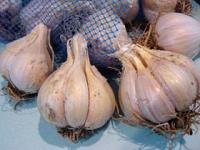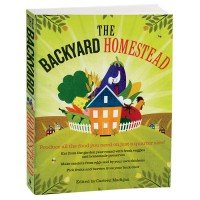


On Emeril Lagasse's cooking show on television, one of the times that the audience always applauds is when Emeril uses lots of garlic. Emeril's celebrity has made it acceptable to admit a love of garlic's pungent flavor. But did you know that there are different varieties, with a range of flavors and attributes?
When you go to the grocery, you're most apt to find only "generic" garlic. But go to a farmer's market in the summer and fall, and you'll likely find at least a few of the dozens of garlic varieties available. Why take a chance on finding some of these when it is incredibly easy to grow your own?
Fall is the time to plant garlic cloves. Then, with some occasional weeding, all you have to do is wait until next summer to harvest such treasures as 'Killarney Red', 'Brown Tempest', 'Georgian Crystal', or 'Asian Tempest', each with their own distinctive characteristics. Of course, you could play it simple and just plant some cloves from a garlic bulb bought at the grocery, but where's the adventure in that? The companies that sell garlic for planting usually offer a selection of varieties in small quantities so you can experience the range of flavors and growth characteristics.
Types of GarlicAt its simplest, garlic can be divided into softneck and hardneck types. Hardneck garlic (Allium sativum ssp. ophioscorodon) is characterized by a woody central stalk that usually flowers and, in some varieties, produces topsets. Bulbs produce 5 to 9 large cloves. Hardnecks stand out for the range and quality of flavors, but they usually keep only about 3 months in storage.
Within the category of hardnecks, there are distinctive groups -- each with a number of varieties -- including rocambole, with a rich, hot, long-lasting flavor; purple stripe, which is great for cooking and roasting; and porcelain, which stores better than most hardneck varieties.
Softneck garlic (Allium sativum ssp. sativum) has a soft central stem and non-flowering habit. There may be as many as 18 cloves in a head. Plants are great for braiding and have a storage life of 6 months to a year. Within the softneck category, there is a division called artichoke that is very easy to grow, quite vigorous, and produces very large bulbs. Another division is referred to as silver skin, which is the type most often used for braiding.
How to GrowGarlic is best planted during October or just before the ground freezes. Don't plant too early because you do not want the leaves to grow until spring. Prepare the soil well, using lots of organic amendments and fertilizer several weeks before planting. Remove skins from the bulbs but not the individual cloves, and split the cloves from the bulb just prior to planting. Plant cloves at a depth of 3 inches, 6 inches apart and in rows 6 to 9 inches apart. Spread 3 to 6 inches of mulch over the planted area.
Plants will begin to grow sometime next March. If plants are not emerging, pull back the mulch in case they're having trouble getting through it, but leave it between rows. As the plants grow, remove seed heads from the hardneck varieties when the stems uncurl and become straight.
Bulbs are usually ready for harvest sometime in July, depending on the weather and the variety. The time to harvest is when there are three to six green leaves left. Remove the whole plant and place out of direct sunlight with good air circulation. Plants can be hung or placed on screening. It usually takes three weeks for the bulbs to dry, then cut the bulbs from the stems and cut the roots off close to the bulb. Gently remove any loose skins and soil. Store in a basket or mesh bag in a dry, dark area at 60 to 65 degrees F.
Other AlliumsWhile you're ordering and planting garlic this fall, why not try some of the other fall-planted onion family members, including shallots, potato onions, walking onions, and elephant garlic (which is really a leek). Easy to grow, they'll add even more flavors to your food.
Planting Chart
The Top 10 Best Companion Plants


 The food industry's digusting secrets exposed. How to protect yourself.
Click Here!
The food industry's digusting secrets exposed. How to protect yourself.
Click Here!

